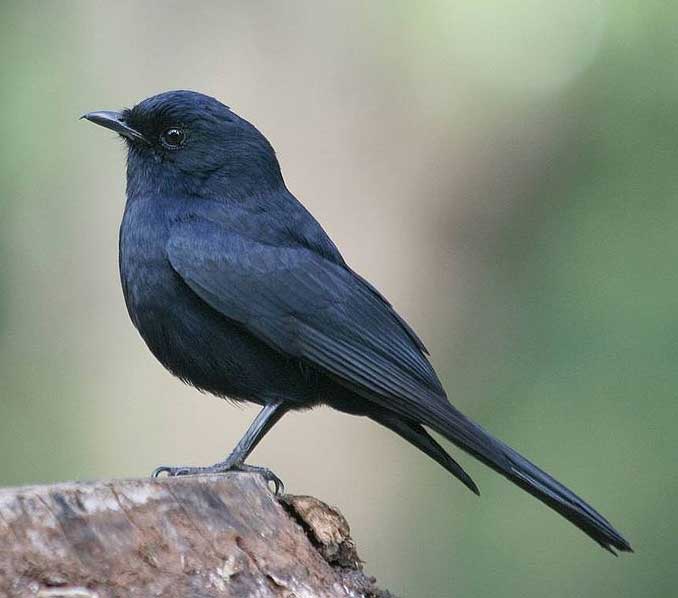
Melaenornis pammelaina (*)
Superregnum: Eukaryota
Cladus: Unikonta
Cladus: Opisthokonta
Cladus: Holozoa
Regnum: Animalia
Subregnum: Eumetazoa
Cladus: Bilateria
Cladus: Nephrozoa
Superphylum: Deuterostomia
Phylum: Chordata
Subphylum: Vertebrata
Infraphylum: Gnathostomata
Megaclassis: Osteichthyes
Cladus: Sarcopterygii
Cladus: Rhipidistia
Cladus: Tetrapodomorpha
Cladus: Eotetrapodiformes
Cladus: Elpistostegalia
Superclassis: Tetrapoda
Cladus: Reptiliomorpha
Cladus: Amniota
Classis: Reptilia
Cladus: Eureptilia
Cladus: Romeriida
Subclassis: Diapsida
Cladus: Sauria
Infraclassis: Archosauromorpha
Cladus: Crurotarsi
Divisio: Archosauria
Cladus: Avemetatarsalia
Cladus: Ornithodira
Subtaxon: Dinosauromorpha
Cladus: Dinosauriformes
Cladus: Dracohors
Cladus: Dinosauria
Cladus: Saurischia
Cladus: Eusaurischia
Subordo: Theropoda
Cladus: Neotheropoda
Cladus: Averostra
Cladus: Tetanurae
Cladus: Avetheropoda
Cladus: Coelurosauria
Cladus: Tyrannoraptora
Cladus: Maniraptoromorpha
Cladus: Maniraptoriformes
Cladus: Maniraptora
Cladus: Pennaraptora
Cladus: Paraves
Cladus: Eumaniraptora
Cladus: Avialae
Infraclassis: Aves
Cladus: Avebrevicauda
Cladus: Pygostylia
Cladus: Ornithothoraces
Cladus: Ornithuromorpha
Cladus: Carinatae
Parvclassis: Neornithes
Cohors: Neognathae
Cladus: Neoaves
Cladus: Telluraves
Cladus: Australaves
Ordo: Passeriformes
Subordo: Passeri
Infraordo: Passerida
Superfamilia: Muscicapoidea
Familia: Muscicapidae
Genus: Melaenornis
Species: Melaenornis pammelaina
Subspecies: M. p. ater – M. p. diabolicus – M. p. pammelaina – M. p. poliogygna – M. p. tropicalis
Name
Melaenornis pammelaina (Stanley, 1814)
References
Voyage to Abyssinia App. p.lix
Vernacular names
Afrikaans: Swartvlieëvanger
English: Southern Black Flycatcher
español: Papamoscas sudafricano
français: Gobemouche sud-africain
The southern black flycatcher (Melaenornis pammelaina) is a small passerine bird of the genus Melaenornis in the flycatcher family, Muscicapidae, native to open and lightly wooded areas of eastern and southern Africa.[2][3]
This species has a large range, with an estimated global extent of occurrence of 4,000,000 square kilometres (1,500,000 sq mi). The global population size has not been quantified but the bird is listed by the IUCN as being of "Least concern".
Description
The southern black flycatcher is entirely black, with a black beak and black legs. The iris of the eye is brown and this, along with the square-cut tail, helps distinguish it from the otherwise similar fork-tailed drongo (Dicrurus adsimilis) which has a red iris and long forked tail.[4]
Distribution and habitat
The southern black flycatcher is native to eastern and southern Africa. It has been recorded from Somalia, Kenya, Tanzania, Rwanda, Burundi, Congo, the Democratic Republic of the Congo, Angola, Namibia, Eswatini, Botswana, Malawi, Mozambique, Zambia, Zimbabwe, Lesotho and South Africa.[1] It is typically found in habitats with open areas and light woodland, riparian corridors, the edges of plantations and in gardens. The trees in these habitats include miombo (Brachystegia spp.), thorntrees (Acacia spp.) and mopane (Colosphermum mopane).[5]
Behaviour
The southern black flycatcher is a mainly insectivorous bird. Its diet includes beetles, termites, locusts, worms, spiders and centipedes. Its main foraging technique is to perch on a low eminence such as a branch or fence post and pounce on prey in the air or on the ground below. It is also known to sip nectar from the flowers of mountain aloe (Aloe marlothii) and to eat the berries of the black nightshade (Solanum nigrum). It sometimes forages in small flocks, often associating with fork-tailed drongos.[5][6] Possible benefits for this association is a lower predation risk and a higher foraging success.[7]
Breeding takes place between May and January, peaking in September and October. The nest is usually built in a recess in a tree trunk or behind a loose slab of bark, but is sometimes in a tangle of creepers, the sheath of a palm frond, banana bunch or an abandoned farm implement. It is cup-shaped and composed of twigs and dry grasses, lined with fine rootlets. Up to four eggs are laid and incubation lasts about two weeks with the young fledging and leaving the nest in fifteen to twenty days.[5]
Status
The IUCN list the southern black flycatcher as being of "Least concern". This is because it has a wide range, approximately 4,000,000 square kilometres (1,500,000 sq mi), the population seems stable and the bird is said to be common over at least part of its range.[8]
References
BirdLife International (2018). "Melaenornis pammelaina". IUCN Red List of Threatened Species. 2018: e.T22709085A132079602. doi:10.2305/IUCN.UK.2018-2.RLTS.T22709085A132079602.en. Retrieved 13 November 2021.
Taylor, Barry (2020). "Southern Black-flycatcher (Melaenornis pammelaina)". Birds of the World.
Melaenornis pammelaina
"Southern Black Flycatcher". BirdForum. Retrieved 2014-06-07.
"Melaenornis pammelaina (Southern black flycatcher)". Biodiversity Explorer. Izico. Retrieved 2014-06-07.
Fraser, Warwick (1983). "Foraging patterns of some South African flycatchers". Ostrich: Journal of African Ornithology. 54 (3): 150–155. Bibcode:1983Ostri..54..150F. doi:10.1080/00306525.1983.9634464.
Morgan, Tc; McCleery, Ra; Moulton, Mp; Monadjem, A (August 2012). "Are Southern Black Flycatchers Melaenornis pammelaina associated with Fork-tailed Drongos Dicrurus adsimilis ?". Ostrich. 83 (2): 109–111. Bibcode:2012Ostri..83..109M. doi:10.2989/00306525.2012.690351. ISSN 0030-6525. S2CID 83726699.
"Southern Black Flycatcher Melaenornis pammelaina". BirdLife International. 2014. Retrieved 2014-06-07.
Retrieved from "http://en.wikipedia.org/"
All text is available under the terms of the GNU Free Documentation License

